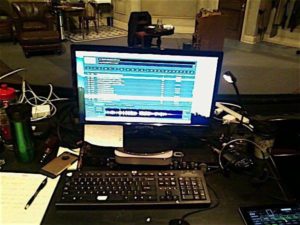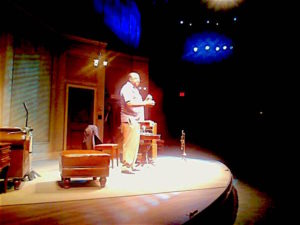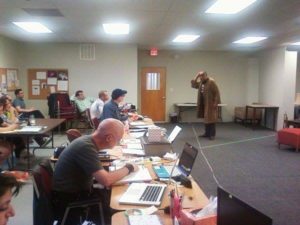 Over the weekend I spent two consecutive twelve-hour working days in technical rehearsals for my Palm Beach Dramaworks production of Satchmo at the Waldorf. I say “my” because I wrote the play and am directing it, but nothing drives home the collaborative nature of theater quite like tech, in which the director, design team, and stage crew of a show work hand in hand to build, polish, and rehearse the lighting and sound cues that transform what happened in the rehearsal hall to what will happen in front of an audience.
Over the weekend I spent two consecutive twelve-hour working days in technical rehearsals for my Palm Beach Dramaworks production of Satchmo at the Waldorf. I say “my” because I wrote the play and am directing it, but nothing drives home the collaborative nature of theater quite like tech, in which the director, design team, and stage crew of a show work hand in hand to build, polish, and rehearse the lighting and sound cues that transform what happened in the rehearsal hall to what will happen in front of an audience.
Tech is a grueling, painstaking, time-consuming process that requires infinite patience. If you’re a naturally impatient person—as I am, I regret to say—it can be tedious in the extreme. But if—as I also am—you’re the kind of person who has a taste for taking infinite pains, then it can be one of the most engrossing and pleasurable experiences that theater has to offer. It’s the Orson Welles part of stage directing: you get to pull out the toy box and spend hours and hours playing with it. You fuss endlessly and productively over every single lighting cue, making one part of the stage dark and another bright, with the lighting designer saying “Do you like it better this way, or this way?” over and over again like a demented ophthalmologist.
 I tweeted about our tech rehearsals as they were in progress, and a jazz-singing friend of mine who has also worked in theater responded as follows:
I tweeted about our tech rehearsals as they were in progress, and a jazz-singing friend of mine who has also worked in theater responded as follows:
Tech has always been my favorite part of the rehearsal process. Such a joy and relief to incorporate lights, sound, and costumes after you’ve been stuck in a rehearsal room pretending they’re there. It’s when the production becomes real, and you get to work through all the magical technical moments.
My—our—production of Satchmo is full of such moments, a few of which are sufficiently surprising that I don’t want to give them away. Most, though, are intended to be so subtle as to escape the conscious notice of the audience. Their purpose is to heighten the atmosphere of the show without drawing attention to themselves, and to make you concentrate all the more closely on the action and actors.
In the case of Satchmo, we have only one actor, Barry Shabaka Henley, who did the show earlier this year in Chicago in a completely different-looking production. I’ve found it inspiring to watch Shabaka adjust with seeming effortlessness to this new setting, and to see his interpretation of the triple role of Louis Armstrong, Joe Glaser, and Miles Davis grow richer and more complex with each passing day. Like John Douglas Thompson and Dennis Neal before him, he is a true artist, and I am lucky beyond words to have him doing the show.
 That said, tech is less about the actor than about the people you don’t see on stage, and I couldn’t begin to say enough about them. Mike Amico, his wife Erin, Kirk Bookman, and Matt Corey, designed the set, costumes, lighting, and sound for Satchmo, and they are, each and every one, masters of their crafts. So are James Danford and Ashley Horowitz, the stage manager and assistant manager, who (if I may mix my metaphors) keep the balls in the air and make the trains run on time. Between them, they’ve all helped to turn the production in my head into a living, breathing thing, and it is no false modesty but the simple truth when I say that I couldn’t have even begun to do it without them.
That said, tech is less about the actor than about the people you don’t see on stage, and I couldn’t begin to say enough about them. Mike Amico, his wife Erin, Kirk Bookman, and Matt Corey, designed the set, costumes, lighting, and sound for Satchmo, and they are, each and every one, masters of their crafts. So are James Danford and Ashley Horowitz, the stage manager and assistant manager, who (if I may mix my metaphors) keep the balls in the air and make the trains run on time. Between them, they’ve all helped to turn the production in my head into a living, breathing thing, and it is no false modesty but the simple truth when I say that I couldn’t have even begun to do it without them.
All of which brings us to the eve of the moment of truth. Tonight is the final dress rehearsal. The first public preview of Satchmo at the Waldorf is Wednesday, with a second preview the next day. We—we—open on Friday. So far, so good. As of this morning, those are the eight happiest words I know.
